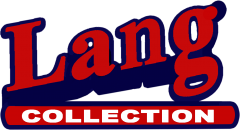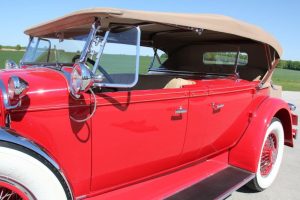1929 MODEL 645 PACKARD DIETRICH DUAL-COWL PHAETON NO 06
“Ask The Man Who Owns One”
This classic beauty was delivered to Goldner Brothers Motor Company, Germantown, PA on June 28, 1929. The car was sold to a gentleman with the initials DMW but, like most Packards, official documentation was destroyed in the CW wind-up of Packard-Studebaker in 1959. That same year, David Wilson discovered and acquired this rare 145” wheelbase Packard in Tennessee and drove it home to Indiana. Beginning in 1964, the car was restored by C. D. McClarey of Indianapolis, making its debut at the 1968, Indianapolis CCCA Grand Classic, scoring 95 points. Dr. Wilson has provided a detailed chronology of the vehicle history, until its 2004 sale to a Florida collector. In 2013, the 1929 Model 645 joined the Lang Collection in Chepstow Ontario. The original condition and provenance merited a full restoration that would replicate the original design mastery and craftsmanship of Ray Dietrich.
This 1929 Model 645 Packard Dietrich Dual-Cowl Phaeton includes the following options: Bijur chassis lubricator, Trippe lights, and optional cigar lighter reaching from dash to back seat. The car was completely dismantled and cataloged. The frame was media blasted, sanded and painted. The engine was overhauled with new cylinder liners and the crankshaft turned and polished.
All wood was removed and patterns made, larger pieces reproduced by CNC machine and smaller pieces hand- carved. Chrome was stripped and replated. The wheels have been respoked and new tires mounted.
The chassis was overhauled, including transmission, brakes and running gear. The two-tone red paint was chosen from Packard paint chips. Seats and interior are reupholstered in Woolsdorf leather original design in Finesse parchment, with matching tan square-weave wool carpets. Original top and side-curtains have been replaced with tan Stayfast canvas.
The Model 645 Dual Cowl Sport Phaeton weighs 5165 Lbs and cost $5985 new. The 384.4 cu in engine produces 105 hp and comes with a 3 speed transmission. Only 2061 Packard 645’s were built for 1929 and it is believed that less than 100 being Dual Cowl Sport Phaetons.
Some 85 years following its original introduction, this 1929 Model 645 Packard Dietrich Dual-Cowl Phaeton was chosen “PEOPLE’S CHOICE” at the 2015 COBBLE BEACH CONCOURS event
This gorgeously restored vehicle also won the “Meguiar’s Award For The Car With The Best Shine and Finish” at the 2016 AMELIA ISLAND COURSE D’ELEGANCE.
The Coach Builders
Around the turn of the Twentieth Century building horse drawn wagons and carriages was already a big business. So when automobiles first came on the scene, these carriage builders were faced with a choice. Several like Durant in Flint MI and McLaughlin in Oshawa changed over to building the new horseless carriages themselves. Meanwhile others stayed in the business of building custom bodies for the elite chassis builders like Packard, Peerless, and Duesenberg into the 1930’s. These are the vehicles bearing the great designs you see in collections like The Lang Collection.
Many, but not all, of the best coach builders of the period were to be found in and around New York City. People who could afford one of these designs on one of these expensive chassis could afford to go to New York to pick out a builder. We will look at one such company that was formed in early 1920 by young designers Ray Dietrich (1894-1980) and Tom Hibbard (1898-1982). They met while working at Brewster Inc. Coach Builders before going out on their own founding LeBaron - Carrossiers to design and build custom bodies for wealthy customers. They chose that name because neither Dietrich’s name nor Hibbard’s was then known outside Brewster and LeBaron – Carrossiers sounded like it had that touch of class needed to succeed in this upscale market. Both Dietrich and Hinbbard’s names would, in short order, also be well known.
So LeBaron opened offices in New York City at the prestigious No 2 Columbus Circle on Broadway in a building owned by William Randolph Hearst. Thomas Hibbard’s friend, Ralph Roberts, was taken on as a partner to handle the book keeping and because he could advance the $700.00 needed to incorporate the company.
The business plan for LeBaron was to create the renderings and full size body drafts for a customer, then have a local or regional coachbuilder build a prototype body. They would charge each customer, either a large flat fee or small design fee combined with a royalty if the body would enter volume production. Alternately their customer could order just the design and body drafts, then arrange to have the body built themselves.
One of LeBaron’s early customers was New York auto dealer Milton Budlong. Lincoln had shipped him one of their new sophisticated yet homely Lincoln models designed by Angus Woodbridge, Henry Leland’s son-in-law. The car was marvelous mechanically but the body was widely ridiculed by dealers and customers alike. Budlong felt that with a properly designed and built body on that chassis, they would have a real attention getter. LeBaron built such a vehicle for the September 1920 New York Auto Show in just 21 days and LeBaron’s name and reputation was established. While most of their business came from dealers some did come from chauffeurs and walk-in customers
Hibbard left LeBaron in 1923 to work with Howard “Dutch” Darrin (1897-1982) (see the Lang Collection `54 Kaiser Darrin) to design exotic cars in Paris while Dietrich left for Detroit in 1925 where he designed many vehicles like Lincoln’s for Edsel Ford and eventually developed the relationship for which he would most be remembered with Alvan Macauley, President of the Packard Motor Car Company.















